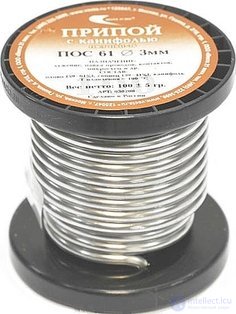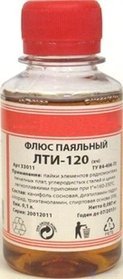Lecture
Solders of various grades have different properties depending on the combination of tin, lead, bismuth, copper, zinc, cadmium, silver. Solders have components that form alloys with joined metals. Only some of the brands of solder are designed to assemble electronic modules. Currently, traditional and lead-free solders are used. Traditional solders - tin-lead alloys or close to them. Solder is available in the form of cast ingots, rods, wire or a thin tube containing a filler similar to the flux to facilitate soldering. In the molten state, the solder should ensure good wetting of the surfaces to be joined and the ductility, a sufficiently strong mechanical connection of the parts after cooling down the soldering. Of the traditional grades for the installation of components on the boards, POS 61 grade solder is used. Solders having a melting point below 450 ° C are called soft, if higher - hard solders. The maximum melting temperature of solders for the assembly of electronic modules is 300 ° C. The eutectic phenomenon is used to reduce the melting point of the solder. The ratio of metals in the alloy when the melting point becomes lower than that of any of the metals in the alloy is eutectic. Solder is an alloy that has the eutectic property.

Solder the pic 61.
The combination of solder components allows to obtain high-quality soldering, which withstands a wide range of temperatures during operation of the electronic module.
Solders for assembly of electronic modules:
|
Mark |
Composition |
The temperature of complete melting of the solder, ° C |
|
POSSU 61-0,5 |
tin 61%, antimony 0.5%, lead 38.5% |
189 |
|
Pic 61 |
tin 61%, lead 39% |
190 |
|
POS 61M |
tin 61%, lead 37%, copper 2% |
192 |
Lead-free solders should replace lead-containing. The European Law Commission has banned the use of lead in electronics manufacturing since 2006. Lead-free alloys have a higher strength compared to tin and lead alloys, resistance to temperature changes and are recommended for soldering components with different thermal expansion coefficients. Lead-free soldering matt. Lead-free solders are more expensive due to their high silver content.
The heated solder is connected to metals if the surfaces of the parts to be brazed are cleaned, in other words, the films of oxides formed over time are mechanically removed.
Flux is a nonmetallic material used for the chemical cleaning of surfaces to be joined and providing bond strength in the soldering area. During soldering, flux dissolves oxides and sulfides on the surfaces to be joined. Residual flux should not change the electrical characteristics of materials and does not cause corrosion. When the solder melts, the flux is distributed over the surface of the liquid metal. During soldering, the joining surfaces must be protected from oxygen. And this problem is solved by the flux, which forms a protective film over the soldering area. Acid-free fluxes based on highly volatile components are used for the installation of radio elements on the boards. The composition of the flux is due to the need to adsorb with solder and the main substance of the flux of surface-active oxygen, as well as its partial release, thereby changing the surface tension and wetting ability. The flux should be easily removed after the installation is completed, as the flux residues can become further corrosion centers.
Fluxes for the assembly of electronic modules:
|
Flux |
Composition |
|
CE |
Rosin 10 ... 40%, alcohol 60 ... 90%, |
|
GK |
Rosin 6%, alcohol 80%, glycerin 14% |
|
LTI |
Rosin 22%, alcohol 70%, aniline hydrochloric acid 6%, triethanolamine 2%, |
|
FPET |
Resin PN-9 or PN-56 15 ... 50%, ethyl acetate 50 ... 85% |
|
FCET |
Rosin 10 ... 60%, ethyl acetate 40-90% |
|
Fksp |
Rosin 10 ... 60%, ethyl alcohol or ethyl acetate 40 ... 90% |
One of the most common and accessible fluxes for soldering boards is the CE grade flux.

Flux FKSp.
Flux alcohol-cased SCF (FKSp) its varieties: CE, FCE, FKSp. It is used: for soldering on the boards of radio-wiring elements at temperatures of 250-280 ° C.

Flux LTI-120.
LTI-120 flux is designed not only for soldering boards, but also for carbon steels and zinc by solders at a temperature of 200 ... 300 ° C. PN-9, PN-56 - fluxes, which include rosin or polyester resins. These fluxes are suitable for soldering copper, brass, silver, gold; their remnants do not reduce the electrical resistance of the bases of the boards and do not cause corrosion. Fluxes FKSp, FKET and FPET are also used for the preservation of boards for long periods of storage as coatings.
Board assembly technologies depend on the installed electronic components and can be divided into several basic types. Output mounting - on-board only components that are installed in the holes. Mixed installation - on the board there are planar components and output. Surface mounting - only planar components.
Comments
To leave a comment
Design and engineering of electronic equipment
Terms: Design and engineering of electronic equipment